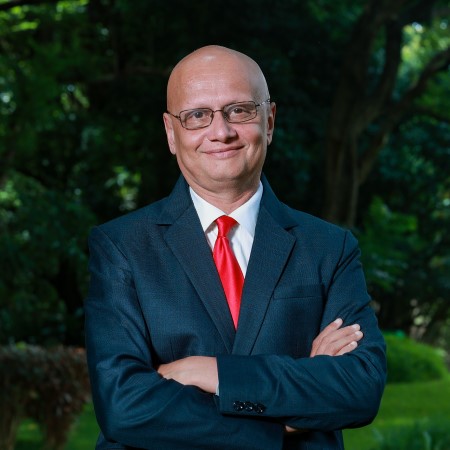Vision Possible: Why Eyestem Is 'Bullish' About Its Dry AMD Candidate
Executive Summary
Eyestem founder and CEO talks to Scrip about progress made by the firm’s experimental treatment for dry age-related macular degeneration, cell and gene therapy pricing considerations and the wider competitive landscape. The company is also developing treatments for retinitis pigmentosa and idiopathic pulmonary fibrosis.
Eyestem is advancing its experimental treatment for dry age-related macular degeneration (dry AMD), backed by an underlying vision to develop a scalable cell therapy platform to treat incurable diseases and democratize access to these newer technologies.
Dr Jogin Desai, Founder & CEO, Eyestem

In an interview with Scrip, the Indian cell therapy firm’s founder and CEO, Dr Jogin Desai, said that he’s "very bullish" that Eyestem’s investigational dry AMD candidate, Eyecyte-RPE, “will show human results, which will be equal or hopefully better than anything else out there.”
Eyecyte-RPE is a suspension of retinal pigment epithelium cells and Eyestem hopes to enrol its first patient for trials of this treatment in the second quarter of 2023. There is currently no cure for dry AMD.
The development landscape for dry AMD treatments, though, is buzzing with activity – some reports estimate that there are over 40 active players in the fray, though Desai is unfazed and says the addressable market is huge.
The executive outlined why Eyestem steered clear of complement-directed therapeutics for dry AMD but wishes all those following that approach well “because we're all in the same boat. We're trying to solve a big problem.”
Complement inhibitor products such as Apellis Pharmaceuticals, Inc..’s intravitreal pegcetacoplan are moving through the FDA review system for treatment of geographic atrophy, an advanced form of age-related macular degeneration that has no currently approved treatments. (Also see "Apellis Has New Hope for Pegcetacoplan With Longer-Term Data" - Scrip, 16 Mar, 2022.)
Desai, who was previously part of the global leadership team at Quintiles and headed its cardiac safety business from 2001 to 2007, also flagged up the “nice patient data,” including some reversal of vision loss coming from Lineage Cell Therapeutics, in the area. On 28 November, Lineage announced the launch of a Phase IIa study by partner Genentech, Inc. of RG6501 in patients with geographic atrophy secondary to AMD.
Business opportunities notwithstanding, access and affordability issues are at the core of Eyestem’s wider mission. Desai noted that while cell therapies are generally expected to follow the gene therapy cost model, price points like in the case of Luxturna (voretigene neparvovec) can’t be the way forward. Roche Holding AG/Spark Therapeutics, Inc.’s one-time injection Luxturna came with a US list price $425,000 per eye — a total of $850,000 for the full treatment.
“For a small group of patients that still may be okay. But when you're talking about 170 million people in the world who suffer from dry AMD, a price point like that just doesn't make any sense, not just for India, but even for the world,” Desai, a former CEO of Cenduit, underscored.
“So what we want to do is get price points which are say, 1/50th of what a price point is in the US.”
Eyestem’s CEO also outlined how things are shaping for the firm’s other pipeline assets for retinitis pigmentosa and idiopathic pulmonary fibrosis. Find out more in this podcast.
Podcast Time Stamps
00:08 Introduction
02:29 How the Eyestem dream began
06:29 Progress with Eyestem’s experimental treatment for Dry AMD
07:51 Enrolling the first patient by Q2 of 2023
09:03 Partnering Oregon Health and Science University
11:02 Cell therapies are expected to follow the gene therapy cost model
12:21 Our protocols are scalable
14:51 Partnering conversations with big pharma
16:35 Quality and efficacy are table stakes in this business.
17:38 Views on competition
18:38 'Nice' patient data from Lineage Cell Therapeutics
20:00 Successful Series A round
22.10 Remaining lean and fit to achieve our purpose
23:07 Change in Indian biotech funding appetite?
24:57 Advancing the IPF asset
28:00 Eyestem five years down the line
This and all our other podcasts are available on the Pharma Intelligence channel on Apple Podcasts, Google Podcasts, SoundCloud, TuneIn and Spotify Podcasts, and via smart speakers if one of these platforms has been set up as your default podcast provider.
Related Stories:
( (Also see "Gene And Cell Therapies In Asia: Indian Environment Evolving But Multiple Issues Unresolved" - Scrip, 29 Sep, 2019.))
(Also see "It’s Coming Home: ImmunoACT Advances Plans For Cut-Price CAR-T In India" - Scrip, 30 Jun, 2022.)
(Also see "Ex-Eylea Leader Launches Biotech Targeting Untapped Eye Market" - Scrip, 24 Feb, 2022.)
